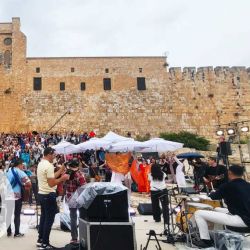To read the full report, click here
Walking in preparation for the Jubilee of the Resurrection in 2033
From the very beginning of the vision of JC2033, the Holy Land has played an important role, since it all began in a garden in Jerusalem, almost 2000 years ago. But how do we relate to it, and in particular to Jerusalem, where everything is so complicated? We pondered this question in prayer.
That's when the idea came to us to invite people to walk along the road to Emmaus in preparation for the Jubilee of 2000 years since his resurrection, every year until 2033. We read the story in Luke's Gospel in four stages: Emmaus, a way, an encounter, a word, and a meal.
Emmaus, a way
We began the first day by sharing our "existential Emmaus journeys". Inspired by the Global Christian Forum's approach, each person is invited to say how they have walked with Christ, in seven minutes, in small groups of seven people.
Gethsemane
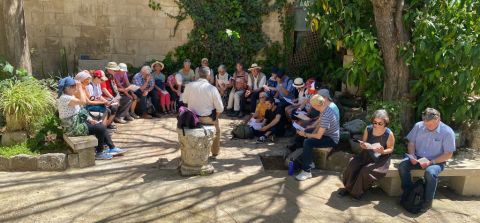 A blessed time of meditation in the Hermitage of Gethsemane
A blessed time of meditation in the Hermitage of Gethsemane
Then we went to the Hermitage of Gethsemane: a place where Jesus stopped before walking the Way of the Cross. This tranquil spot with a magnificent view of the old town is owned by the Franciscans. Brother Diego welcomes us and explains the meaning of the garden.
We then dispersed for an hour of silence, during which we were invited to give thanks for our personal Emmaus journeys, by writing a text or a prayer.
Via Dolorosa and Basilica of the Resurrection
At the Lion's Gate, our first guide is waiting for us. He takes us along the "Via Dolorosa" to the "Anastasis", the "Basilica of the Resurrection", where the Holy Sepulchre is located.
Behind the S. Sepulchre is a tomb from the time of Jesus, used by the Syriac Orthodox Church on feast days. Without doubt, it gives the best idea of the tomb of Jesus as it was originally.
Here we sing "Thine be the Glory", in French and English. It was a beautiful moment, in a place that is rarely visited, just as the crowds were rushing to visit the Holy Sepulchre!
Emmaüs, an encounter
The next day, we walk from Neve Illan to Emmaus-Nicopolis and meditate on "Emmaus, an encounter". We note that Jesus takes the first step and an interest in them by asking a question. Through dialogue, he creates a relationship with them.
Arriving at Emmaus-Nicopolis, we were met by Brother Johannes, from the Community of the Beatitudes who showed us around the archaeological site of the ancient Byzantine Basilica.
The resurrection, the peace of Jerusalem
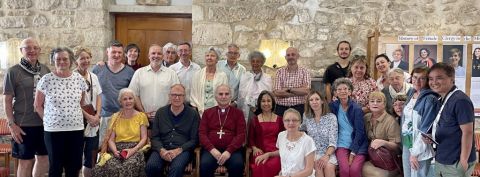 The group with Ibrahim Azar, Bishop of the Evangelical Lutheran Church in the Holy Land
The group with Ibrahim Azar, Bishop of the Evangelical Lutheran Church in the Holy Land
On the morning of Wednesday 19 April, we went to "Muristan", next to the Church of the Redeemer, to meet the Lutheran bishop Ibrahim Azar, who explained to us the origins of his family, going back almost to apostolic times. He tells us how his Church wants to bear witness to the Risen Lord. For him, the Road to Emmaus is the image of the Church on the move with its Saviour in its midst, guiding, inspiring and continually reforming it. His resurrection is the secret of the peace of Jerusalem.
"A cordial presence”
On Thursday 20 April, we visit the Benedictine monastery of Abu Ghosh, with its church built by the Crusaders in the 12th century. A possible location for the ancient Emmaus! Here we meet Brother Olivier, a colourful speaker, who explains the vision of this monastery: "To be a cordial presence, at the sources of our faith, listening to the mystery of Israel, without exclusion".
Many Jews, alone or in groups, visit the monastery, as well as groups made up of Jews and Arabs.
Emmaus, a Word
After visiting the Saxum centre in the heights of Abu Gosh, we meditated on the third aspect: Emmaus, a Word. Emmaus is above all a Gospel trail. Through dialogue, Jesus built a relationship with the disciples. Their initial hostility gave way to listening and respect.
Yad Hashmonah and the Messianic Jewish community
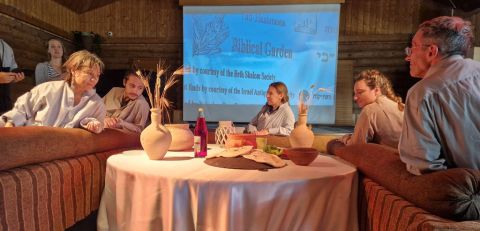 The "Biblical meal" in the Yad Hashmonah restaurant
The "Biblical meal" in the Yad Hashmonah restaurant
At Yad Hashmonah, not far from Neve Illan where our walk took us, we discovered this "Moshav" founded by a group of Finnish Christians. The manager of the hotel at the top of the village, Tsuriel Bar David, explains to us the origins of this place where a community of 70 Messianic Jewish families now live.
Emmaus, a meal
We begin Friday at the Garden Tomb, where we spend a moment savouring its peace, and savouring the truth written at the entrance to the tomb: "He is not here, he is risen" (Mat. 28.6).
Before walking towards Motza, we meditate on the fourth point in the story: Emmaus, a meal. When Jesus arrived at Emmaus, it was as if he wanted to continue his way. But where was he going? To the Father's house! The Eucharist is not just a memory, but an encounter in which Jesus takes us by the hand to lead us to the Father, says Martin Hoegger.
Motza, the real Emmaus ?
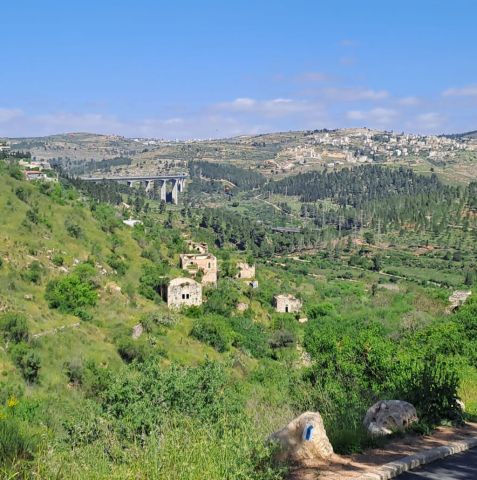 On the way to Motza
On the way to Motza
In the Yellin house in Motza, Kokavah Peterman-Lipshitz, who runs this place of remembrance and, above all, is a passionate archaeologist, shows us that Motza may be identified with the real Emmaus. Some remarkable archaeological discoveries have been made recently, including a Byzantine church and another from the Crusader era.
Why else would Christians have settled here as early as the 4th century, if not because they had identified it with Emmaus?
Next year in Jerusalem!
On our last evening, we took stock of this wonderful week. Thanks to the times of sharing, we immediately discovered that we were brothers and sisters in Christ. Opening our hearts to one another and focusing on the Word of the Risen Lord is the key to unity.
In a way, the road to 2033 is a road to Emmaus. What we have experienced by walking in unity and diversity is a beautiful symbol of what we want to experience with the JC2033 initiative.
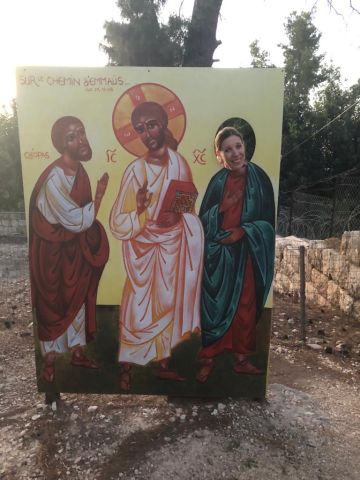 At Emmaus Nicopolis, you can become the other disciple, next to Cleopas. Was he a woman, his wife, as some think? The fact that he is not mentioned would indicate that everyone can identify with him.
At Emmaus Nicopolis, you can become the other disciple, next to Cleopas. Was he a woman, his wife, as some think? The fact that he is not mentioned would indicate that everyone can identify with him.
Texts by Martin Hoegger with Olivia Manderson, Jane Maire and Andrew Taylor.



